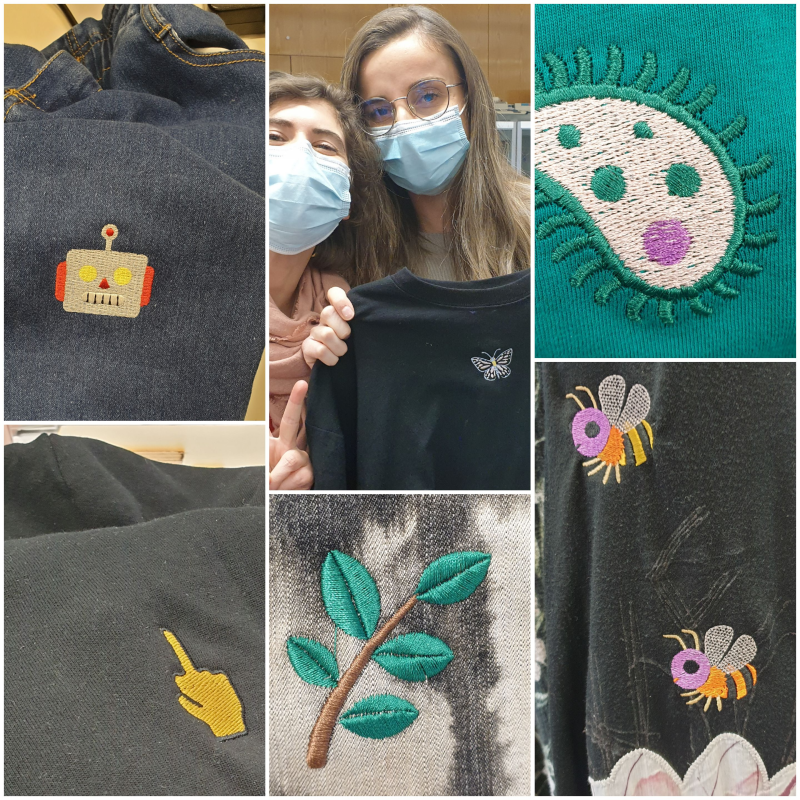Upcycling clothes with embroidered emoji: Difference between revisions
Anne Payen (talk | contribs) No edit summary |
mNo edit summary |
||
| Line 10: | Line 10: | ||
This project had rather satisfying results. Indeed, 20 designs were made for the 16 participants. But only 4 participants asked to upcycle but all expressed a future interest in saving their textiles through embroidery. In general participants were pleased with the results and most also expressed a desire to learn more. | This project had rather satisfying results. Indeed, 20 designs were made for the 16 participants. But only 4 participants asked to upcycle but all expressed a future interest in saving their textiles through embroidery. In general participants were pleased with the results and most also expressed a desire to learn more. | ||
== | == Market needs and Concept testing == | ||
[[File: | |||
=== Market needs === | |||
The purpose is to evaluate whether there is a need for upcyling clothes with embroidery and test the idea use emoji. | |||
[[File:Noun-interview-4145355.png|alt=|thumb|Interview]] | |||
'''Interview''' | '''Interview''' | ||
| Line 19: | Line 22: | ||
* Do you know what upcycling is? | * Do you know what upcycling is? | ||
Or in relation to their willingness to reduce their clothing waste/ find a way to be more | Or in relation to their willingness to reduce their clothing waste/ find a way to be more sustainable : | ||
* Would you be willing to pay for a service that offers you the opportunity to keep your clothes and reduce your waste ? | * Would you be willing to pay for a service that offers you the opportunity to keep your clothes and reduce your waste ? | ||
| Line 28: | Line 31: | ||
* Do you ever have problems while managing your clothes? Is it hard for you to discard old clothing? | * Do you ever have problems while managing your clothes? Is it hard for you to discard old clothing? | ||
Then it would be important to present our service, explain its purpose and how it achieves this goal. Ideally we could show how it can solve some of the concerns raised during the interview. | Then it would be important to present our service, explain its purpose and how it achieves this goal. We could for example show the following picture | ||
[[File:Upcycling-with-emoji.png|none|thumb|800x800px|Upcycling with emoji]] | |||
Ideally we could show how it can solve some of the concerns raised during the interview. | |||
After | ==== Concept testing ==== | ||
After market needs evaluation, it would be necessary to present an example of upcycled clothing: show pictures of the garment before the transformation and then show the final result to highlight the difference. Finally we could also consider a more practical example that would give the interviewees the opportunity to see how the upcycling process is done: from the selection of the motif (https://edutechwiki.unige.ch/fr/Liste_des_emojis_%C3%A0_broder), scanning, testing, reshaping and the final embroidery on the clothing. | |||
After that, we will focus on issues related to the implementation of this service. How would they prefer it to be? Would they like to come and drop off their clothes themselves and explain in person what designs they would like to add to their clothes? Or would they rather choose the designs from home, simply placing the order remotely and have their garment shipped to the institution's address? | After that, we will focus on issues related to the implementation of this service. How would they prefer it to be? Would they like to come and drop off their clothes themselves and explain in person what designs they would like to add to their clothes? Or would they rather choose the designs from home, simply placing the order remotely and have their garment shipped to the institution's address? | ||
Another important aspect to analyse is the price. Therefore we should also ask about the price they would be willing to pay for this type of service. Finally we could ask for suggestions to improve our product. For example ask if the idea of upcycling clothes with an emoji is good or if other designs would be more interesting. | Another important aspect to analyse is the price. Therefore we should also ask about the price they would be willing to pay for this type of service. Finally we could ask for suggestions to improve our product. For example ask if the idea of upcycling clothes with an emoji is good or if other designs would be more interesting. | ||
Revision as of 16:54, 22 April 2022
This page on Creating Upcycling clothes with embroidered emoji describes a product development case.
Setting context
Before detailing the steps that we will follow in the launch of this project.
It should be pointed out that a similar project had already been launched. Indeed, on Thursday 11 to Friday 12 November 2021 between 10am and 6pm at the FacLab of the University of Geneva, was launched upcycling workshops with emoji embroidery, see https://faclab.ch/node/76 . Workshops that aimed to upcycle clothes by embroidering emojis on them.
This project had rather satisfying results. Indeed, 20 designs were made for the 16 participants. But only 4 participants asked to upcycle but all expressed a future interest in saving their textiles through embroidery. In general participants were pleased with the results and most also expressed a desire to learn more.
Market needs and Concept testing
Market needs
The purpose is to evaluate whether there is a need for upcyling clothes with embroidery and test the idea use emoji.
Interview
We should start by asking engaging questions. In relation with the service we want to offer such as:
- Would you like a way to bring your used clothing back to life?
- Do you know what upcycling is?
Or in relation to their willingness to reduce their clothing waste/ find a way to be more sustainable :
- Would you be willing to pay for a service that offers you the opportunity to keep your clothes and reduce your waste ?
We can also ask them questions about their management of their used clothing and if they are facing any constraints regarding the management of their clothing:
- What do you do with your used clothes or damaged clothes? Do you throw them away ? do they resell them? do they give them away?
- Do you ever have problems while managing your clothes? Is it hard for you to discard old clothing?
Then it would be important to present our service, explain its purpose and how it achieves this goal. We could for example show the following picture
Ideally we could show how it can solve some of the concerns raised during the interview.
Concept testing
After market needs evaluation, it would be necessary to present an example of upcycled clothing: show pictures of the garment before the transformation and then show the final result to highlight the difference. Finally we could also consider a more practical example that would give the interviewees the opportunity to see how the upcycling process is done: from the selection of the motif (https://edutechwiki.unige.ch/fr/Liste_des_emojis_%C3%A0_broder), scanning, testing, reshaping and the final embroidery on the clothing.
After that, we will focus on issues related to the implementation of this service. How would they prefer it to be? Would they like to come and drop off their clothes themselves and explain in person what designs they would like to add to their clothes? Or would they rather choose the designs from home, simply placing the order remotely and have their garment shipped to the institution's address?
Another important aspect to analyse is the price. Therefore we should also ask about the price they would be willing to pay for this type of service. Finally we could ask for suggestions to improve our product. For example ask if the idea of upcycling clothes with an emoji is good or if other designs would be more interesting.

